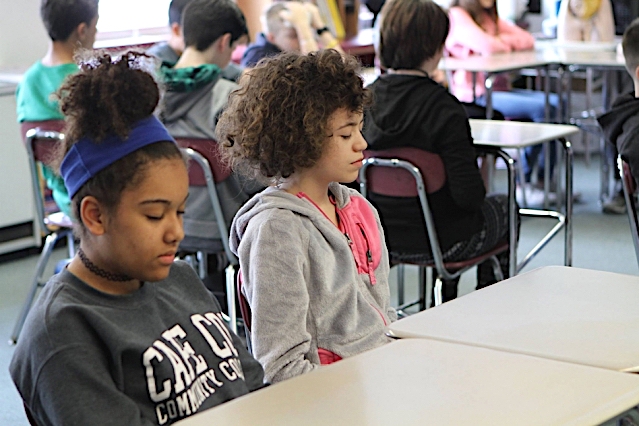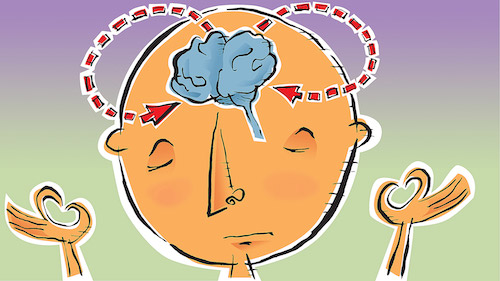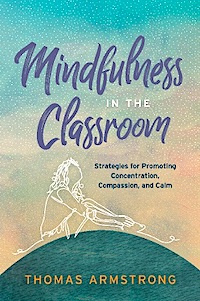Mindfulness Practices: Made for Middle School

I don’t think that there’s any other group along the continuum of human life who can benefit more from mindfulness practices than kids in middle school.
From a neuroscience perspective, their emotional brain or limbic system has pretty much been installed and is fully functional, making them more vulnerable to the stress of emotional reactivity. Meanwhile, the more rational prefrontal cortex of the brain still has years to go until it reaches full maturity.
The result: Middle schoolers are kids who – metaphorically speaking – have their foot on the gas pedal while their brakes have yet to be installed.
This very fact has led some parents and educators to wonder whether kids in early adolescence can sit still long enough to practice mindfulness in the first place. In this article, I’d like to explore several reasons why the answer is a definite yes and to argue that kids should practice mindfulness at the middle school level on a regular basis.
Mindfulness is simply a technique
First, you might ask, what is mindfulness? To some people it conjures up images of people making pretzels of their bodies, listening to sitar music, coloring mandalas, or taking guided trips into the core of one’s imagination. But it’s really none of those things.
It’s something far simpler. Mindfulness is the intentional focus of the mind on each present moment in time with a curious and nonjudgmental attitude.
The most common way of practicing mindfulness is to simply sit on the floor or in a chair, close one’s eyes, and pay attention to one’s breathing: to the inflow and outgo of air through the nostrils, or to the rising and falling of the chest or stomach. The instructions are that if one is distracted from this task (by anything, such as a thought, an emotion, a sensation, or a perception), to simply notice the interruption and then return one’s focus to the breath.
For teachers who have concerns about students not being able to sit calmly for more than a minute or two, there’s also walking meditation, where students are instructed to walk in a circle or in a designated straight line (this is best done outdoors) and have the focus this time, not on the breath, but on the sensations of contact that their feet make with the ground.
Another good ‘’moving’’ practice is mindful stretching, which repurposes a few ancient yoga poses as vehicles for contemplation. For example, students might stand on one leg with their other leg pressed onto the inside of their thigh above or below the knee, while stretching their hands high above their heads. The essence of this practice is to hold this pose while focusing on the bodily sensations of one’s stretched muscles.
Anticipating resistance (and giggling)
A potential roadblock to an effective mindfulness practice at the middle school level may have to do with kids’ acute self-consciousness at this time in life and their reluctance to do any out-of-the-ordinary things, especially when performed in the presence of their peers.
As one teen put it: ‘’At first, I kind of rejected the practice because it made me too vulnerable, with its awkward poses and asking me to close my eyes. I didn’t want to look – weird.”
Expect there to be giggling, nervousness, or even horseplay at the beginning, but as repeated exercises begin to make the practice more familiar, these behaviors are likely to subside after a time of adjustment.
Another possible snafu has to do with the suspicion which middle school students sometimes have toward any one in authority telling them what to do, especially if the teacher lacks the experience or earned trust to do so. That’s why it’s very important for teachers to earn credibility with their students by starting a mindfulness practice of their own.
Many teachers have attended mindfulness workshops for educators run by organizations such as Mindful Schools, MindUP, and Still Quiet Place. Others have used apps like Headspace or Calm to guide themselves through the process (and using these apps in the classroom with students can also help teachers avoid being the ‘’heavy’’ who is giving out all the orders).
It’s important that students see that this is not something being done to them, but rather a stress reducing tool that students are fully in control of at all times. As one teacher told his students: ‘’I am not the boss of what happens inside your head.’’
Peer-influenced mindfulness practice
Since tweens would rather be with their peers than listening to adults, build in opportunities for peer-led mindfulness sessions where, on a rotating basis, students get to ring a bell to start a mindfulness session, and then ring it again at the end.
In one study where students were also instructed to do mindfulness practices at home, results indicated that students were more likely to follow the instructions if they thought that their friends were also doing the same thing at their homes.
Students might also like to teach what they’ve learned to younger kids. In one school, kids were at a schoolwide assembly when the younger elementary school kids started acting very restless. A small group of 6th graders spontaneously got up and led the whole assembly in some mindful stretching and breathing exercises. The district superintendent reported that ‘’every kid in the audience quieted down.’’
What’s the evidence that it works?
Some teachers might be asking: this all sounds well and good, but does it work? In other words, are these practices evidence-based? The answer to this question is “yes” – and fresh research is coming out all the time showing the power of mindfulness to develop a wide range of capabilities, including improved executive functioning, better working memory, and improved academic achievement.
In one recent study (June 2019), researchers from Harvard and Yale discovered that higher levels of mindfulness in grades 5-8 students are associated with better academic achievement as measured by grade point average, and standardized tests of mathematics and literacy. They also demonstrated greater improvement in academic performance from the prior school year, better attendance, and fewer suspensions.
There are also indications that mindfulness practices have a direct effect upon the brain’s functioning. In another recent study at MIT (August 2019), 40 middle school students were randomized into two groups, one of which practiced mindfulness at school for eight weeks, and the other group which took a course in computer coding. At the end of the study, students who practiced mindfulness reported lower levels of stress, and this correlated with results obtained from having their brains scanned using fMRI technology.
In the fMRI part of the study, students’ brains were scanned while looking at pictures of faces showing different emotions. Students who had practiced mindfulness had less activation of their right amygdala when shown fearful faces. The amygdala has a central role in the initiation of both acute and chronic stress responses. Moreover, students who practiced mindfulness showed improved connectivity between the amygdala and the ventromedial prefrontal cortex, which was indicative of improved emotional regulation.
Time to try mindfulness in your school?
A third of our adolescents report feeling depressed or overwhelmed because of stress, and their single biggest source of stress is school, according to the American Psychological Association. With promising studies such as these and unprecedented levels of stress among middle schoolers and high schoolers, there’s never been a better or more crucial time to implement mindfulness practices into middle school.
You needn’t worry that a three- or -four-minute mindfulness session will derail your lesson plan. The truth is that teachers are more likely to save time in the long run doing brief mindfulness practices at the start of a class, because instead of taking valuable time getting kids to settle down from a previous class, lunch or recess, the session puts students quickly into a centered state conducive to focusing attention on the lesson.
Yes, it will take some time to make mindfulness practices “routine” in your school, but it’s time well-invested. Middle school is a crazy time of life, with hormones and neurotransmitters raging, social cliques and romantic partners vying for attention, the attractions of substance abuse at the verge, the threat of mental illness lurking, the constant shuffle from one class to another, the pressure of homework and exams, the often disturbing physical changes going on in one’s body, and the hours of daily time spent trying to manage one’s status on social media.
All these things conspire to take tweens’ very identity away from them. In the midst of that, mindfulness offers a quiet time where they can recoup their dignity and recapture a sense of stability.
As one 7th grade boy put it: “You try to be popular and you try to want everybody to like you and you never want to be you . . . but this [mindfulness practice] helps you be mindful of your body and yourself. It’s ‘being you,’ basically.” The real you.
CREDITS
Photo: MIT News, “Two studies reveal benefits of mindfulness for middle school students.”
Illustration: Harvard Gazette, “When Mindfulness Meets Science”
__________________________
Thomas Armstrong, Ph.D. has been an educator for over 45 years. He is the author of 19 books which have been translated into 28 languages, including Mindfulness in the Classroom: Strategies for Promoting Concentration, Compassion, and Calm (ASCD, 2019). Learn more about his work at his website: The American Institute for Learning and Human Development. Follow him on Twitter @Dr_Armstrong.







































